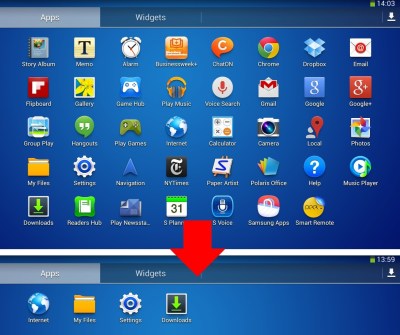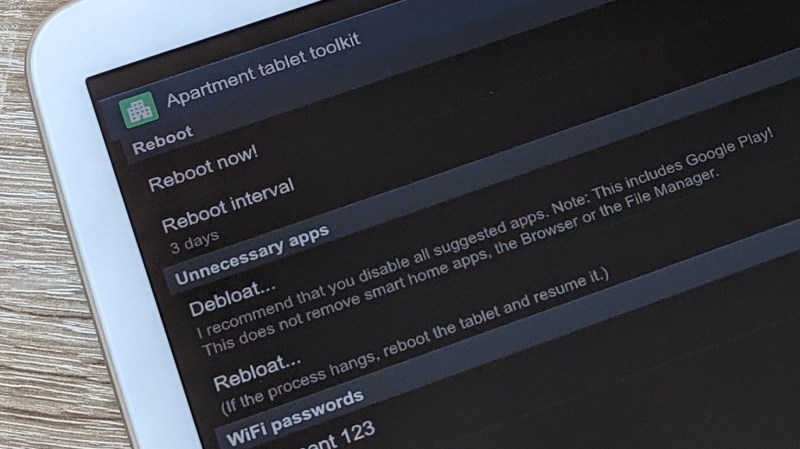Are you ready for a tale of poorly supported hardware, clueless contractors, and bad coding? Look no further than [Neighborino]’s excellent write-up where he details his pursuit of smart home pwnership.
[Neighborino]’s smart home system controls the windows, blinds, outlets, and HVAC. But by the time the high-rise apartment was ready for occupancy in 2015, the smart home controllers were already showing their age. You see, the contractor had installed an app to run the home’s programmable logic controllers (PLCs) on stock Galaxy Tab 3 hardware. Yes, that’s a tablet originally released in 2013. They then built the tablets into the wall of each apartment, dooming the homeowner to rely on the vendor forevermore.
It was not long before [Neighborino] and their fellow residents were dealing with stability problems. Bloatware from both Samsung and Google was causing major slowdowns, and the PLC system’s unpublished WiFi password prevented replacement of the controllers.
Being an Android developer by trade, [Neighborino] set siege to the walled garden before him. The writeup details the quest to execute what would be a straightforward hack on anything but the x86 hardware that was being targeted.

The first fruit of [Neighborino]’s efforts was a hack for the aged tablets that would display the WiFi password, allowing owners to connect their own controllers to their smart homes. Of course, this is Hackaday, so you know that [Neighborino] didn’t stop there.
Despite having to deal with two different versions of Android and tablets that were built into the wall of the apartments of non-hacker neighbors, [Neighborino] succeeded in sideloading an APK. This freed them from the shackles of the company that installed the original system and gets longer life out of their Snowden-era Samsungs. A de-bloating tool frees up memory and restores the systems to a nearly performant status. A reboot scheduler keeps the x86 tablets running without user intervention, and of course the WiFi password revealer makes yard waste out of the previously walled garden.
If Smart Home hacks are your thing, we recently covered a Voice Controlled Smart Home setup, and less recently another that combined a Smart Home with a Dumb Terminal. Be sure to share your own smart home hacks with us via the Tip Line!
















Sigh.
This is something we’re going to see forever in smart homes.
Builders are going to install the flavor of the month from whoever sells it most cheaply. It’s already the norm with “builder grade” carpet, plumbing fixtures and lighting.
Most customers can’t tell the difference, so why would the guy who installs the furnace chosen exclusively by price spend time working out an open-source solution that isn’t going to show it’s worth for 10 years after the sale has closed?
I’ve seen this with hardwired switches to control ceiling fans. The switch looks like something normal, but communicates wirelessly for the different speed control and dimming signals. That’s great until the switch breaks and you can’t buy them anymore. Then what do you do with your fan.
No multiply that complexity, and the compound how exotic the parts are and expensive to replace, and you have the current state of smart home equipment.
Seems like there are truckloads of money awaiting whomever can fix this. Or possibly not… all it would take is a standard that became widely adopted but nobody selling this stuff wants to give up their chance at recurring subscriptions from these devices.
I just went through that myself. I liked the fan I had, but it was the control board inside that failed. New remote wouldn’t pair with it, so then I tried wiring it for direct voltage control from the switch, but it had some exotic magnet and winding combo that made finding the right capacitor difficult. Spent more than the cost of a new fan on many trials of capacitors and different switches and still have all of it and now the fan is squeaking so there’s that.
Because in the U.K., houses get a 10 year guarantee.
A couple of companies will get burnt, or at least tied up in expensive lawsuits, and then they’ll realise they need an open standard which allows homeowners to change stuff easily.
Wait a minute, the Tab 3 was x86-based? While I don’t use it anymore, I still have one! Perhaps I could do something with it…
Whoops, didn’t mean to post this as a reply.
Also, update: I had the 7″ model, and not the one in the article.
This is about half the plot of “Unauthorized Bread”
Even though the tablet was an x86-based Android, the author provides a nice rundown of various Android rooting & crack programs for that version. One of them even provides a list for other versions of Android.
Here’s one that should give people pause. T-Mobile’s Home Internet High Speed Gateway has a fixed IP address of 192.168.12.1
You cannot change it. If you don’t want to have to upend the configuration of everything on your home network, you’ll have to hang a WiFi router off one of the T-Mobile gateway’s two ethernet ports so it can be configured to slot in place of your old DSL modem.
But fixing the T-Mobile gateway to that one IP address is like keeping the “Protected by ADT” yard sign at your house after having a new ADT security system installed. Burglars who hack alarm systems will know what tricks to use to bypass or disable it.
People probing your setup, if they can see 192.168.12.1 will instantly know what your Internet connection is and what exploits to try, should any be found for the grey cylinder.
T-Mobile needs to be made to see the folly of not allowing the gateway IP address to be changed, or at least allowing the user to choose from 192.168.0.1, 192.168.1.1, 172.16.0.0, or 10.10.0.0 for the gateway IP.
That address the ipv4 LAN side of the router… And not visible from the internet.
This type of “smart” home gear amounts to a sad joke from a sustainability and stability perspective. Whoever puts garbage like this into walls of houses sucks at their profession. Kudos to the poor soul having to hack around the faults of this setup in order to make it tolerable for users a couple more years down the line (hopefully). We need to go back to home automation and away from flashy short lived gadgets calling themselves “smart”.